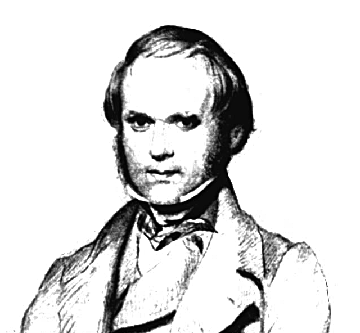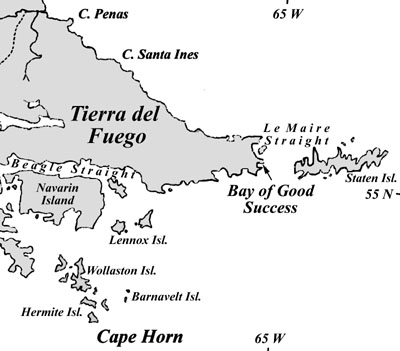free
trial issue
subscribe
back
issues
Athena Review, Vol. 1, No.3
Darwin at Terra del Fuego (1832)
 The
British survey ship H.M.S. Beagle, under Captain Fitz Roy, circumnavigated
the globe in 1831-1836. Aboard the ship as naturalist was Charles Darwin,
then a young man in his mid- to late twenties. During this voyage, Darwin
began to formulate the theories later published in his landmark study of
evolution, The Origin of Species (1859). One of the Beagle's most
important stops was at Tierra del Fuego, where Captain Fitz Roy was returning
to their homeland three natives of the Yahgan tribe he had taken to England
a few years previously: a boy named Jemmy Button, a girl named Fuegia Basket,
and a man named York Minster. Darwin's commentary, taken from Chapter 10
of his Journal of Researches on the Voyage of the Beagle (1839; revised
1845), alternates between the beautiful wilderness of Tierra del Fuego, the
unpredictable ways of the native Fuegians, and his own
reflections on the wide differences between human societies.
The
British survey ship H.M.S. Beagle, under Captain Fitz Roy, circumnavigated
the globe in 1831-1836. Aboard the ship as naturalist was Charles Darwin,
then a young man in his mid- to late twenties. During this voyage, Darwin
began to formulate the theories later published in his landmark study of
evolution, The Origin of Species (1859). One of the Beagle's most
important stops was at Tierra del Fuego, where Captain Fitz Roy was returning
to their homeland three natives of the Yahgan tribe he had taken to England
a few years previously: a boy named Jemmy Button, a girl named Fuegia Basket,
and a man named York Minster. Darwin's commentary, taken from Chapter 10
of his Journal of Researches on the Voyage of the Beagle (1839; revised
1845), alternates between the beautiful wilderness of Tierra del Fuego, the
unpredictable ways of the native Fuegians, and his own
reflections on the wide differences between human societies.
[Fig.1: Portrait of Darwin as a young man in
his 20s.]
"December 17th, 1832. - ... A little
after noon we doubled Cape St. Diego, and entered the famous strait of Le
Maire. We kept close to the Fuegian shore, but the outline of the rugged,
inhospitable Staten-land was visible amidst the clouds.
In the afternoon we anchored in the Bay of Good Success.
...While entering we were saluted in a manner becoming the inhabitants of
this savage
 and
forbidding land. A group of Fuegians partly concealed
by the entangled forest, were perched on a wild point overhanging the sea;
and as we passed by, they sprang up and waving their tattered cloaks sent
forth a loud and sonorous shout. In the morning the captain sent a party
to communicate with the Fuegians. . . . It was without exception the most
curious and interesting spectacle I ever beheld: I could not believe how
wide was the difference difference between a savage and civilized man: it
is greater than between a domesticated and wild animal, inasmuch as in man
there is a greater power of improvement. The chief spokesman was old
- and appeared to be the head of the family; the three others were powerful
young men about six feet high.. .The old man had a fillet of white feathers
tied round his head, which partly confined his black, coarse, and entangled
hair. His face was crossed by two broad transverse bars; one, painted bright
red, reached from ear to ear and included the upper lip; the other, white
like chalk, extended above and parallel to the first, so that even his eyelids
were thus coloured. The other two men were ornamented by streaks of black
powder, made of charcoal . . .
and
forbidding land. A group of Fuegians partly concealed
by the entangled forest, were perched on a wild point overhanging the sea;
and as we passed by, they sprang up and waving their tattered cloaks sent
forth a loud and sonorous shout. In the morning the captain sent a party
to communicate with the Fuegians. . . . It was without exception the most
curious and interesting spectacle I ever beheld: I could not believe how
wide was the difference difference between a savage and civilized man: it
is greater than between a domesticated and wild animal, inasmuch as in man
there is a greater power of improvement. The chief spokesman was old
- and appeared to be the head of the family; the three others were powerful
young men about six feet high.. .The old man had a fillet of white feathers
tied round his head, which partly confined his black, coarse, and entangled
hair. His face was crossed by two broad transverse bars; one, painted bright
red, reached from ear to ear and included the upper lip; the other, white
like chalk, extended above and parallel to the first, so that even his eyelids
were thus coloured. The other two men were ornamented by streaks of black
powder, made of charcoal . . .
[Fig.2: Map of Tierra del Fuego, and the eastern
side of the Straight of Magellan.]
"Their very attitudes were abject,
and the expression of their countenances distrustful, surprised, and startled.
After we had presented them with some scarlet cloth, which they immediately
tied round their necks, they became good friends. This was shown by the old
man patting our breasts, and making a chuckling kind of noise, as people
do when feeding chickens.. I walked with the old man, and this demonstration
of friendship was repeated several times; it was concluded by three hard
slaps, which were given me in the breast and back at the same time. He then
bared his bosom for me to return the compliment, which being done, he seemed
highly pleased...."
Athena Review Image
Archive™ |
Paleoanthropology in
the News
| Guide
to Archaeology on the Internet |
Free issue
|
Back issues
Main index of Athena
Review |
Subject Index
| Travel
Pages |
Galleries and
Museums |
Ad
rates |
Current issue
index |
Copyright © 1996-2001 Athena
Publications, Inc. (All Rights Reserved).
 The
British survey ship H.M.S. Beagle, under Captain Fitz Roy, circumnavigated
the globe in 1831-1836. Aboard the ship as naturalist was Charles Darwin,
then a young man in his mid- to late twenties. During this voyage, Darwin
began to formulate the theories later published in his landmark study of
evolution, The Origin of Species (1859). One of the Beagle's most
important stops was at Tierra del Fuego, where Captain Fitz Roy was returning
to their homeland three natives of the Yahgan tribe he had taken to England
a few years previously: a boy named Jemmy Button, a girl named Fuegia Basket,
and a man named York Minster. Darwin's commentary, taken from Chapter 10
of his Journal of Researches on the Voyage of the Beagle (1839; revised
1845), alternates between the beautiful wilderness of Tierra del Fuego, the
unpredictable ways of the native Fuegians, and his own
reflections on the wide differences between human societies.
The
British survey ship H.M.S. Beagle, under Captain Fitz Roy, circumnavigated
the globe in 1831-1836. Aboard the ship as naturalist was Charles Darwin,
then a young man in his mid- to late twenties. During this voyage, Darwin
began to formulate the theories later published in his landmark study of
evolution, The Origin of Species (1859). One of the Beagle's most
important stops was at Tierra del Fuego, where Captain Fitz Roy was returning
to their homeland three natives of the Yahgan tribe he had taken to England
a few years previously: a boy named Jemmy Button, a girl named Fuegia Basket,
and a man named York Minster. Darwin's commentary, taken from Chapter 10
of his Journal of Researches on the Voyage of the Beagle (1839; revised
1845), alternates between the beautiful wilderness of Tierra del Fuego, the
unpredictable ways of the native Fuegians, and his own
reflections on the wide differences between human societies.
 and
forbidding land. A group of Fuegians partly concealed
by the entangled forest, were perched on a wild point overhanging the sea;
and as we passed by, they sprang up and waving their tattered cloaks sent
forth a loud and sonorous shout. In the morning the captain sent a party
to communicate with the Fuegians. . . . It was without exception the most
curious and interesting spectacle I ever beheld: I could not believe how
wide was the difference difference between a savage and civilized man: it
is greater than between a domesticated and wild animal, inasmuch as in man
there is a greater power of improvement. The chief spokesman was old
- and appeared to be the head of the family; the three others were powerful
young men about six feet high.. .The old man had a fillet of white feathers
tied round his head, which partly confined his black, coarse, and entangled
hair. His face was crossed by two broad transverse bars; one, painted bright
red, reached from ear to ear and included the upper lip; the other, white
like chalk, extended above and parallel to the first, so that even his eyelids
were thus coloured. The other two men were ornamented by streaks of black
powder, made of charcoal . . .
and
forbidding land. A group of Fuegians partly concealed
by the entangled forest, were perched on a wild point overhanging the sea;
and as we passed by, they sprang up and waving their tattered cloaks sent
forth a loud and sonorous shout. In the morning the captain sent a party
to communicate with the Fuegians. . . . It was without exception the most
curious and interesting spectacle I ever beheld: I could not believe how
wide was the difference difference between a savage and civilized man: it
is greater than between a domesticated and wild animal, inasmuch as in man
there is a greater power of improvement. The chief spokesman was old
- and appeared to be the head of the family; the three others were powerful
young men about six feet high.. .The old man had a fillet of white feathers
tied round his head, which partly confined his black, coarse, and entangled
hair. His face was crossed by two broad transverse bars; one, painted bright
red, reached from ear to ear and included the upper lip; the other, white
like chalk, extended above and parallel to the first, so that even his eyelids
were thus coloured. The other two men were ornamented by streaks of black
powder, made of charcoal . . .